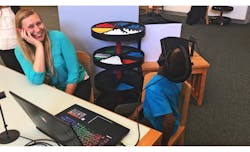It makes sense that virtual reality would improve learning—after all, it’s immersive, engaging and experiential all in one. While those may sound like education buzzwords, the bottom line is simple: Kids think it’s cool, and who wouldn’t want to learn about photosynthesis while standing among the ancient redwoods in Muir National Monument among the great redwoods?
But what do the studies say? Is there really data to back up what many of us assume is true, that students learn better within a virtual reality environment?
Various studies from Oklahoma State University, the Pearson Foundation, Houghton Mifflin Harcourt, and the University of California, Irvine have shown that the inclusion of new technology in education increases student performance by providing additional tools teachers can use to engage their students. These tools, such as computers and laptops have all been proven to aid in student learning and subject comprehension. Virtual reality goes one step further by providing an individualistic immersive environment for students that is free of distractions from the outside world.
Virtual reality as a learning tool is not a new concept, though the delivery method has evolved with the emergence of head-mounted displays. Several studies have shown that virtual reality’s immersive learning benefits students and increases test scores.
- In 2006, a study published in the Journal of Cases on Information Technology showed that students using virtual reality as a learning tool increased their mean test scores by 14%. That same year, a study by the Queensland University of Technology noted that “using VR technology is...an effective method of delivering knowledge in the classroom,” and that the “integration of VR technology not only enhances learning, but it also provides participants with real life experience that they can relate to.”
- A 2016 test in China reinforced virtual reality’s effectiveness as a supplemental teaching aide and learning tool. In the study, the passing rate for the groups that engaged with the subject matter in VR was 90%, while the pass rate for the non-VR group—studying the same material—was only 40%.
- A 2010 article from the National Center for Biotechnical Information proclaimed that virtual reality provides an “education pedagogy to enhance learning outcomes beyond that provided by more traditional online or face-to-face development activities.”
- In 2011, a study from the Hong Kong Polytechnic University showed that virtual reality can “enhance students’ learning experiences by providing them with a heuristic and highly interactive simulated virtual environment.”
- A paper published for the 2012 International Conference on Cognition and Exploratory Learning in Digital Age stated that virtual reality helps make the “teaching/learning process more interesting and pleasant to the students while facilitating the teacher’s work during the evaluation performance (testing).”
This increased interest level by students and teachers centers around the ability that virtual reality has to provide individual immersive learning perspectives while presenting students with experiences they might not otherwise be able to explore. These experiences can be delivered in the form of a “virtual field trip”—where students are part of a 360-deg. landscape by viewing films show with virtual reality cameras—or through immersion within a computer-generated environment that takes them to places that are normally unreachable (e.g., outer space, inside the human body, or ancient/prehistoric times).
“Being explorative and fun are essential parts of students’ learning experiences”—Kung Wong Lau, Hong Kong Polytechnic University, 2011
ACT test scores consistently show that less than a third of American students are proficient in science when they take their college entrance examination. Theoretically, these are our best students, so it stands to reason that we need to find new ways to spark enthusiastic learning in the STEM fields. Virtual reality is the best hope for this renewed commitment to science as we watch this revolution unfold.
Steve Grubbs is the co-founder and CEO of VictoryVR, a curriculum-based virtual reality learning company.




